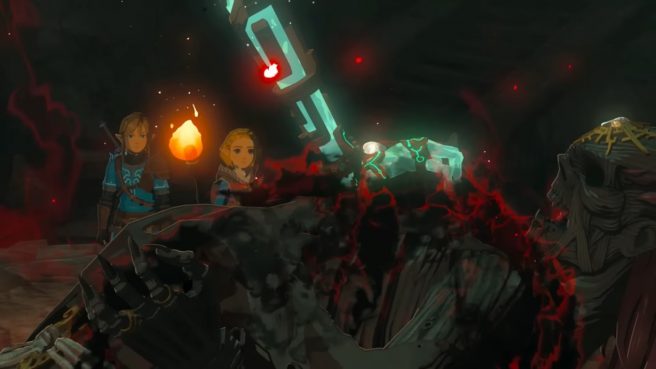Zelda: Tears of the Kingdom devs explain Rauru’s seal, shrines, Lightroots
Hidemaro Fujibayashi and Eiji Aonuma, the director and producer of Zelda: Tears of the Kingdom, have shared interesting information regarding Rauru’s seal – including what it did to Ganondorf – as well as the shrines and Lightroots. This comes as part of a recent interview with Japanese magazine Nintendo Dream that we’ve translated.
We won’t go too much into a summary here as the interview goes into (light) spoilers, but we get to hear about what Rauru’s seal on Ganondorf actually was, the appearance of shrines and Lightroots, and more.
Here’s our full translation:
Speaking of Rauru, it was impressive when Ganondorf was sealed by a hand with a spiral of light coming out of it in the Dragon Tears memories. I thought it was also easy to find above the shrines, but what exactly is that light?
Fujibayashi: In that cutscene, Rauru used his sealing powers to draw out Ganondorf’s magic from his heart and purify it. The released purified magic became a spiral of light. Also, this has to do with the lore of Hyrule Castle, but the original Hyrule Castle was not at that location. We see Ganondorf sealed right under the place of Hyrule Castle in our heroes’ time, which was the best location to keep him sealed. It is like a “dragon vein”*. And Hyrule Castle is one part of the barrier that helps release Rauru’s purification of the evil magic.
* A Chinese Feng Shui concept involving subterranean rivers along Chinese mountain ranges providing resources throughout the region. Also commonly referred to as “Long Mai” or “Dragon Meridians”.
Hyrule Castle played a role like an air purifier! Princess Zelda must have been surprised too.
Fujibayashi: In the Dragon’s Tears memories, Princess Zelda says “Just as I thought, this place is different from the Hyrule I know”, but the original Hyrule Castle is not in the scenery. This is because the world after the Imprisoning War constructed as a strengthening seal for further reinforcement.
But the Hyrule Castle in Tears of the Kingdom is in a truly terrible situation…
Fujibayashi: Hyrule Castle collapsed in Breath of the Wild due to the Calamity and fell into disrepair. As a result, the seal on Rauru’s body in that underground sealing chamber started to gradually fall apart. That’s why only a hand was there when he was found. For that reason, the efficiency of Rauru’s purification began to fall and the seal on Ganondorf began to weaken.
And that is why the shrines appeared on the surface?
Fuibayashi: No, the shrines themselves were built before Rauru founded Hyrule – before the Demon King Ganondorf appeared there were still a lot of evil beings, so Rauru and Sonia went around various places to calm things down. Shrines are placed above where a demon was destroyed so it will not reappear. This is why that spiral of light emerges from the shrine. Therefore, bathing in the remaining power of the shrines slightly cleanses Link of the demon magic.
Aonuma: There are Lightroots in the Depths as well. They’re like air purifiers in both the Surface and the Depths, aren’t they? I guess it is something like a talisman or a statue for protecting against demons.
The names Lightroots and Shrines of Light are linked, or are they anagrams?
Fujibayashi: In Breath of the Wild, in order to verify the optimal size of the world, I investigated my hometown of Kyoto where I understood a sense of distance. As a remnant of that, in Tears of the Kingdom, the shrine names are taken from places in Kyoto. But for example, Nishiouji (a street in Kyoto) as Nishiouji is too on the nose, so the letters were changed to something like “Jioshinio”. Then the name of the connected Lightroot in the Depths is read backwards such as “Onishioji”. I think of Zelda as a series of discovery and exploration, so I think it will be fun to discover a real location if you notice it is a place in Kyoto.
For some reason, it also doesn’t feel very Japanese.
Fujibayashi: I asked a person who could come up with a unique intonation to create it for me. I think it’s not just a simple anagram but a feeling something is a little off, or maybe it is the flair of the staff who were in charge.
We also recently translated comments in which Fujibayashi and Aonuma talked about Zelda, Ganon, and some of the game’s enemies. You can read about that here, here, and here.
Translation provided by Philip Proctor, SatsumaFS, and Simon Griffin on behalf of Nintendo Everything.
